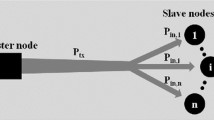Abstract
Sensor network applications are generally characterized by long idle durations and intermittent communication patterns. The traffic loads are typically so low that overall idle duration energy consumption dominates. Low duty cycle MAC protocols are used in order to reduce the energy consumption in idle periods. However, lowering the duty cycle value in favour of energy consumption results in increased latency, which makes this approach undesirable for many practical applications. In this paper, we propose Radio Triggered Wake-up with Addressing Capabilities (RTWAC) that allows suppressing the idle duration current consumption. Our solution consists of an external low-cost hardware wake-up circuit attached to the microcontroller of a sensor node. In order to communicate with a sensor node, a special kind of out-of-band modulated wake-up signal is transmitted. The modulated signal contains data that enables to distinguish between differently addressed nodes in order to avoid undesired node wake-ups. Furthermore, we advocate the idea of combining RTWAC to a MAC protocol running on the normal sensor node radio in order to simultaneously achieve low energy consumption and low latency for reliable data communication.











Similar content being viewed by others
References
J. Ansari, D. Pankin, and P. Mähönen, Radio-triggered wake-ups with addressing capabilities for extremely low power sensor network applications, IEEE 19th International Symposium on Personal, Indoor and Mobile Radio Communications, September 2008.
I. Demirkol, C. Ersoy, and F. Alagoz, MAC protocols for wireless sensor networks: a survey, Communications Magazine, IEEE, Vol. 44, No. 4, pp. 115–121, 2006.
J. Polastre, J. Hill, and D. Culler, Versatile low power media access for wireless sensor networks, Proceedings of the 2nd International Conference on Embedded Networked Sensor Systems (SenSys), Nov. 2004.
I. Akyildiz, W. Su, Y. Sankarasubramaniam, and E. Cayirci, A survey on sensor networks, Communications Magazine, IEEE, Vol. 40, No. 8, pp. 102–114, Aug 2002.
B. Otis, Ultra-low power wireless technologies for sensor networks. Ph.D. dissertation, University of California, Berkeley, 2005.
J. Rabaey, J. Ammer, T. Karalar, S. Li, B. Otis, M. Sheets, and T. Tuan, PicoRadios for wireless sensor networks: The next challenge in ultra-low-power design, IEEE Int’l Solid-State Ckts, 2002.
M. J. Miller and N. H. Vaidya, A MAC protocol to reduce sensor network energy consumption using a wakeup radio, IEEE Transactions on Mobile Computing, Vol. 4, No. 3, pp. 228–242, 2005.
C. Schurgers, V. Tsiatsis, S. Ganeriwal, and M. Srivastava, Optimizing sensor networks in the energy-latency-density design space, IEEE Transactions on Mobile Computing, pp. 70–80, Jan.–Mar. 2002.
L. Gu and J. Stankovic, Radio-triggered wake-up for wireless sensor networks, Real-Time Systems, Vol. 29, pp. 157–182, 2005.
M. Malinowski, M. Moskwa, M. Feldmeier, M. Laibowitz, and J. Paradiso, CargoNet: A low-cost micropower sensor node exploiting quasi-passive wakeup for adaptive asynchronous monitoring of exceptional events, The 5th ACM Conference on Embedded Networked Sensor Systems (SenSys), pp. 145–159, November 2007.
A. Sample, D. Yeager, P. Powledge, and J. Smith, Design of a passively-powered, programmable sensing platform for UHF RFID systems, IEEE International Conference on RFID, March 2007.
B. van der Doorn, W. Kavelaars, and K. Langendoen, A prototype low-cost wakeup radio for the 868 MHz band, International Journal of Sensor Networks (IJSNet), Vol. 5, No. 1, pp. 22–32, 2009.
Atmel Corporation, U3280M transponder interface for microcontroller, datasheet. http://atmel.com/dyn/resources/prod_documents/doc4688.pdf. Last visited: 20.11.2008.
C. A. Balanis, Antenna Theory: Analysis and Design. John Wiley & Sons, Ltd., 1996.
Avago Technologies, Surface mount zero bias schottky detector diodes, HSMS-285x series, datasheet. http://www.avagotech.com/assets/downloadDocument.do?id=2475. Last visited: 20.11.2007.
Maxim Integrated Products, Nanopower, beyond-the-rails comparators MAX9117–MAX9120, datasheet. http://www.datasheets.maxim-ic.com/en/ds/MAX9117-MAX9120.pdf. Last visited: 20.11.2008.
J. Ansari, D. Pankin, and P. Mähönen, Demo abstract: Radio-triggered wake-ups with addressing capabilities for extremely low power sensor network applications, 5th European Conference on Wireless Sensor Networking, 2008.
Acknowledgements
We would like to thank financial support from European Union (Project IST-034963-WASP), Deutsche Forschungsgemeinschaft through the UMIC research center and RWTH Aachen University.
Author information
Authors and Affiliations
Corresponding author
Additional information
This is an extended version of the earlier paper by Ansari et al. [1], presented in IEEE PIMRC 2008.
Rights and permissions
About this article
Cite this article
Ansari, J., Pankin, D. & Mähönen, P. Radio-triggered Wake-ups with Addressing Capabilities for Extremely Low Power Sensor Network Applications. Int J Wireless Inf Networks 16, 118–130 (2009). https://doi.org/10.1007/s10776-009-0100-6
Published:
Issue Date:
DOI: https://doi.org/10.1007/s10776-009-0100-6




